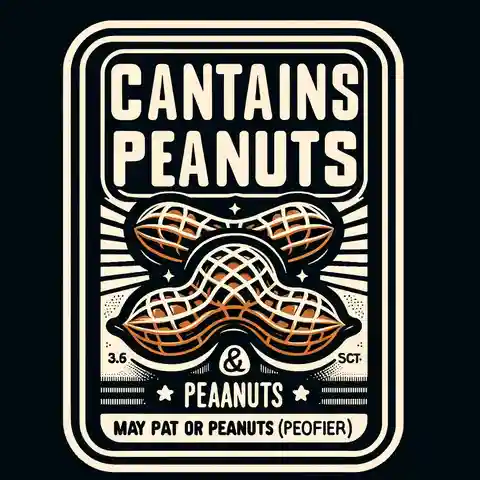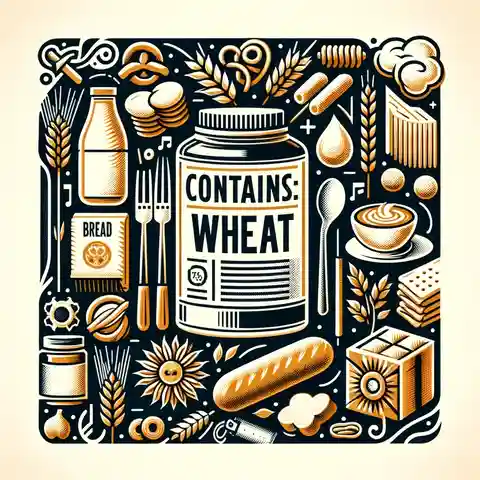Allergy warning label example! Knowing how to read food labels is vital when you or someone you love has food allergies. The law helps by requiring clear labels.
Food allergies can be tricky, but allergy warning labels on food packages are here to help! These labels tell you if something in the food might make some people feel sick. These labels are helpful signs that guide you to pick the right snacks and meals, keeping you safe and happy.
These labels are easy to spot and read. They list things like nuts, milk, and wheat that are common allergies. They make sure you know what’s inside the food using bold letters or a special section that says “Contains.” This way, if you need to avoid certain foods, you can quickly see what to avoid.
Allergy warning labels are there because people care about keeping everyone who eats food safe. They follow rules that ensure all food packages are clear about what’s inside.
So, when you see these labels, they’re like a friend telling you what’s inside the food. Here’s what to look out for:
What Must Be On a Food Allergy Label?
Here’s what needs to be on them:
- List of Ingredients: Everything in the food needs to be listed. If there’s something that can cause allergies, it must be pointed out clearly.
- Major Food Allergens: Some foods cause allergies more than others. These include milk, eggs, fish, shellfish, tree nuts, peanuts, wheat, soybeans, and sesame. Labels have to say if any of these are in the food.
- Name the Allergy Food: If the food has nuts or any allergy-causing stuff, the label has to say exactly which one. Like, if there are almonds, it should say “almonds.”
- “Contains” Words: A special part on the label says “Contains” followed by the names of any allergy-causing foods inside. This helps people know if they should avoid it.
- Warning for Maybe Allergies: Sometimes, foods are made in places where allergy-causing foods are also used. So, labels might say “may contain” or “made in a place that also uses” to warn people.
- Easy to Read: All this important allergy info needs to be easy to see and read on the label so everyone can stay safe.
Always check the label to be sure! So it’s easy to understand and follows the rules for keeping the information clear and helpful.
What are the 14 common allergens on food labels?
Food labels tell us if food has stuff in it that might make some people feel sick because of allergies. There are 14 common allergens that often need to be on labels to help people stay safe. Here they are:
- Milk – This means anything made from cow’s milk like cheese and yogurt.
- Eggs – Not just eggs themselves, but anything made with eggs too.
- Fish – This includes all types of fish.
- Shellfish – Things like shrimp, crabs, and lobsters.
- Tree Nuts – Like almonds, hazelnuts, and walnuts.
- Peanuts – These are different from tree nuts and can cause allergies too.
- Wheat – Found in lots of bread and pasta.
- Soybeans – Used in lots of foods, including tofu and soy sauce.
- Sesame – Seeds and oil from sesame can be in bread or salads.
- Mustard – Not just the condiment, but mustard seeds in other foods.
- Celery – This includes celery stalks, leaves, seeds, and root.
- Lupin – A kind of bean that’s used in some flours and foods.
- Sulphur Dioxide and Sulphites – These are used as preservatives in dried fruit, wines, and more. They’re listed when there’s more than a tiny bit.
- Molluscs – Like clams, mussels, and oysters.
Food labels have to be clear about these allergens to help people know what’s safe for them to eat. If someone has an allergy, they can look at the label and see if any of these allergens are in the food. It’s all about keeping everyone feeling good and healthy
Allergy Warning Label Example
Here’s how you might see allergy warnings for these common allergens on a food label:
Milk Allergy Warning: “Contains: Milk” or “Made with milk ingredients like cheese and yogurt.”

Eggs Allergy Warning: “Contains: Eggs” or “Includes egg-based products.”

Fish Allergy Warning: “Contains: Fish” such as salmon or tuna.

Shellfish Allergy Warning: “Contains: Shellfish” listing specific types like shrimp or lobster.

Tree Nuts Allergy Warning: “Contains: Tree Nuts (almonds, hazelnuts, walnuts).”

Peanuts Allergy Warning: “Contains: Peanuts” or “May contain peanuts.”

Wheat Allergy Warning: “Contains: Wheat” found in bread and pasta.

Soybeans Allergy Warning: “Contains: Soy” including tofu and soy sauce.

Sesame Allergy Warning: “Contains: Sesame” found in some bread or salads.

Mustard Allergy Warning: “Contains: Mustard” or “Includes mustard seeds.”

Celery Allergy Warning: “Contains: Celery” including any part of the plant.

Lupin Allergy Warning: “Contains: Lupin” used in some flour and food products.

Sulphur Dioxide and Sulphites Allergy Warning: “Contains: Sulphur Dioxide/Sulphites” over a certain amount.

Molluscs Allergy Warning: “Contains: Molluscs” such as clams, mussels, or oysters.

Always look at the food package to know for sure what’s inside!
How do you write a food allergy disclaimer?
Writing a food allergy disclaimer is like putting up a sign that helps keep people safe. Here’s how you can write one in a simple and clear way:
- Start with a Friendly Heads-Up: Begin by saying something like, “We care about your health!”
- List the Allergens: Say, “Our foods may include these common allergens: milk, eggs, nuts, and more.”
- Talk About the Kitchen: Mention, “We use the same kitchen to prepare lots of different foods.”
- Be Honest: Add, “Even with care, we can’t guarantee our food is completely free of certain allergens.”
- Advice for Customers: Suggest, “If you have food allergies, please let us know before ordering.”
- Ending Note: Finish by saying, “Thank you for understanding.
It’s all about making sure everyone enjoys their meal without worry!
How are allergens shown on a food label
Allergens are shown on food labels in a few clear ways to make it easy for people to spot them and stay safe. Here’s how allergens are usually listed on food packaging:
- Ingredient List: Allergens are included in the list of ingredients. If an ingredient is made from a common allergen, the allergen’s name will appear in the list. For example, if a product contains an ingredient made from milk, “milk” will be listed.
- Bold or Italic Text: Many food labels highlight allergens by printing them in bold or italic text within the ingredient list. This makes the allergens stand out so you can spot them quickly.
- “Contains” Statement: This is a specific section on the label that says “Contains” followed by the names of any major allergens in the product. For instance, a label might read “Contains: Wheat, Milk, and Soy.”
- Advisory Statements: Some labels include warnings like “may contain” or “produced in a facility that also processes” to inform consumers about potential cross-contamination with allergens not listed as ingredients.
These methods help ensure that if you have allergies, you can easily find out what’s in the food you’re buying and decide if it’s safe for you to eat. Always read labels carefully before consuming any food product.
In Summary
Allergy warning label example are there to help you stay safe. By learning how to read these labels carefully, you can avoid allergens and protect your health. Remember, if you’re ever unsure about a product’s safety, it’s best to leave it out.




